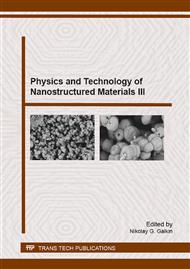[1]
R. Gómez, T. Lopez, X. Bokhimi, E. Muñoz, J.L. Boldú O.J. Novaro, Dehydroxylation and the Crystalline Phases in Sol-Gel Zirconia, J. Sol-Gel Sci. Techn. 11 (1998) 309-319.
DOI: 10.1023/a:1008666531404
Google Scholar
[2]
W. Hu, S. Liu, Y. Zhang, J. Xiang, F. Wen, B. Xu, J. He, D. Yu, Y. Tian, Z. Liu, Annealing-Induced {011}-Specific Cyclic Twins in Tetragonal Zirconia Nanoparticles, J. Phys. Chem. 116 (2012) 21052–21058.
DOI: 10.1021/jp305881r
Google Scholar
[3]
S. Numan, S.S. Habib, Z.H. Khan, F. Djouider, Thermoluminescence and photoluminescence of ZrO2 nanoparticles, Radiat. Phys. Chem. 80 (2011) 923-928.
DOI: 10.1016/j.radphyschem.2011.03.023
Google Scholar
[4]
S. Roy, J.J. Ghose, Synthesis of stable nanocrystalline cubic zirconia, Mater. Res. Bull. 35 (2000) 1195-1203.
DOI: 10.1016/s0025-5408(00)00314-7
Google Scholar
[5]
Gurudayal, A.K. Srivastava, On the emergence of a stabilized cubic phase in pure zirconia thin films at room temperature, J. Kumar, Mater. Lett. 83 (2012) 172-174.
DOI: 10.1016/j.matlet.2012.05.128
Google Scholar
[6]
R.C. Garvie, The Occurrence of Metastable Tetragonal Zirconia as a Crystallite Size Effect, J. Phys. Chem. 69 (1965) 1238-1243.
DOI: 10.1021/j100888a024
Google Scholar
[7]
R.C. Garvie, Stabilization of the tetragonal structure in zirconia microcrystals, J. Phys. Chem. 82 (1978) 218-224.
DOI: 10.1021/j100491a016
Google Scholar
[8]
A. Suresh, M.J. Mayo, W.D. Porter, C.J. Rawn, Crystallite and Grain-Size-Dependent Phase Transformations in Yttria-Doped Zirconia, J. Am. Ceram. Soc. 86 (2003) 360-362.
DOI: 10.1111/j.1151-2916.2003.tb00025.x
Google Scholar
[9]
G. Stefanic, S. Music, Factors Influencing the Stability of Low Temperature Tetragonal ZrO2, Croat. Chem. Acta 75 (2002) 727-767.
Google Scholar
[10]
S. Tsunekawa, S. Ito, Y. Kawazoe, J. -T. Wang, Critical Size of the Phase Transition from Cubic to Tetragonal in Pure Zirconia Nanoparticles, Nano Lett. 3(7) (2003) 871–875.
DOI: 10.1021/nl034129t
Google Scholar
[11]
A. Christensen, E.A. Carter, First-principles study of the surfaces of zirconia. Phys. Rev. B 58 (1998) 8050.
Google Scholar
[12]
C. Ricca, A. Ringuede, M. Cassir, C. Adamo, F. Labat, A comprehensive DFT investigation of bulk and low-index surfaces of ZrO2 polymorphs, J. Comput. Chem. 36 (2015) 9-21.
DOI: 10.1002/jcc.23761
Google Scholar
[13]
A.S. Barnard, R.R. Yeredla, H. Xu, Modelling the effect of particle shape on the phase stability of ZrO2 nanoparticles, Nanotechnology 17 (2006) 3039-3047.
DOI: 10.1088/0957-4484/17/12/038
Google Scholar
[14]
A.S. Barnard, P. Zapol, A model for the phase stability of arbitrary nanoparticles as a function of size and shape, J. Chem. Phys. 121 (2004) 4276-4283.
DOI: 10.1063/1.1775770
Google Scholar
[15]
G. Ballabio, M. Bernasconi, F. Pietrucci, S. Serra, Ab initio study of yttria-stabilized cubic zirconia surfaces, Phys. Rev. B 70 (2004) 075417.
DOI: 10.1103/physrevb.70.075417
Google Scholar
[16]
M. Alfredsson, C.R.A. Catlow, Modelling of Pd and Pt supported on the {111} and {011} surfaces of cubic-ZrO2, Phys. Chem. Chem. Phys. 3 (2001) 4129-4140.
DOI: 10.1039/b102261j
Google Scholar
[17]
W. Piskorz, J. Grybos, F. Zasada, P. Zapała, S. Cristol, J. -F. Paul, Z. Sojka, Periodic DFT Study of the Tetragonal ZrO2 Nanocrystals: Equilibrium Morphology Modeling and Atomistic Surface Hydration Thermodynamics, J. Phys. Chem. C 116 (2012).
DOI: 10.1021/jp3050059
Google Scholar
[18]
R. Docherty, G. Clydesdale, K.J. Roberts, P. Bennema, Application of Bravais-Friedel-Donnay-Harker, attachment energy and Ising models to predicting and understanding the morphology of molecular crystals, J. Phys. D: Appl. Phys. 24 (1991) 89-99.
DOI: 10.1088/0022-3727/24/2/001
Google Scholar
[19]
M. Bockstedte, A. Kley, J. Neugebauer, M. Scheffler, Density-functional theory calculations for poly-atomic systems: electronic structure, static and elastic properties and ab initio molecular dynamics, Comp. Phys. Commun. 107 (1997) 187-222.
DOI: 10.1016/s0010-4655(97)00117-3
Google Scholar
[20]
P. Hohenberg, W. Kohn, Inhomogeneous Electron Gas, Phys. Rev. 136 (1964) B864.
DOI: 10.1103/physrev.136.b864
Google Scholar
[21]
W. Kohn, L.J. Sham, Self-Consistent Equations Including Exchange and Correlation Effects, Phys. Rev. 140 (1965) 1133.
DOI: 10.1103/physrev.140.a1133
Google Scholar
[22]
J.P. Perdew, Y. Wang, Accurate and simple density functional for the electronic exchange energy: Generalized gradient approximation, Phys. Rev. B 33 (1986) 8800.
DOI: 10.1103/physrevb.33.8800
Google Scholar
[23]
N. Troullier, J.L. Martins, Efficient pseudopotentials for plane-wave calculations, Phys. Rev. B 43 (1991) (1993).
DOI: 10.1103/physrevb.43.1993
Google Scholar
[24]
M. Fuchs, M. Scheffler, Ab initio pseudopotentials for electronic structure calculations of poly-atomic systems using density-functional theory, Comp. Phys. Commun. 119 (1999) 67-98.
DOI: 10.1016/s0010-4655(98)00201-x
Google Scholar


